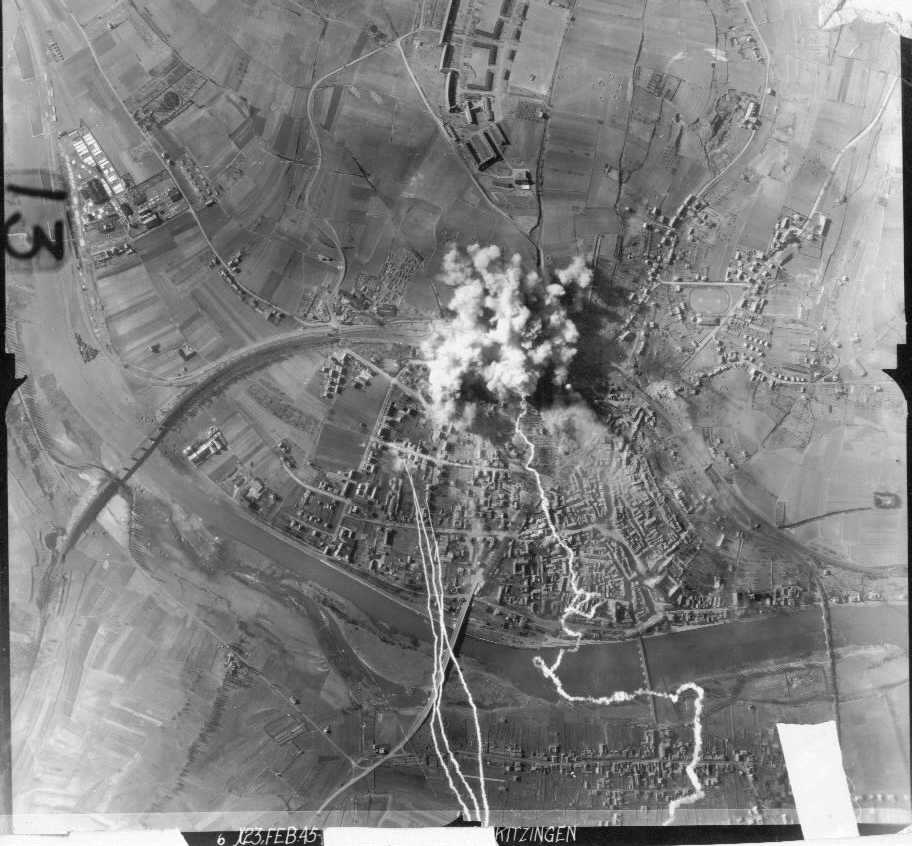
360th BS narrative.

Captain Jones flew as co-pilot for Lt Hatch in the squadron lead plane (AC# 44-8552, PU-X) on this mission. The crewmembers on this plane were:
P Hatch,
Logan B 1st Lt
CP Jones, William
E. Capt.
N Papp,
Melvin E. 1st Lt
B
Downey, Francis G. 1st Lt
Pff Gibson,Cater M
2nd Lt
E
Fuczka, Peter T/Sgt
R
Broughton, Averell M T/Sgt
TG Hardy,James
H F/O
WG Free, Ennis B S/Sgt
Other pilots/planes in the 360ths high squdron on this mission were:
43-38672 Fowler
44-8647 App (Deputy lead)
42-102544 St Julien
42-97546 Bentley
43-38451 Edmunds
43-38563 Stiver
43-38532 Shields
43-38842 Statton
44-6516 Tyler
42-31055 Preston 41st CBW scouter plane
According to the 303rd BG narrative, the group flew as the "B" group
of the 41st CBW. The 303rd BG was lead by William Wisenhart of the
359th BS.
According to this narrative, the primary target at Zwickau was obscurred
by clouds, so the decision was made to attack Kittzengen, but also had
a comment about Crailsheim Germany being a target.
The
AAF combat chronology
indicates that Kittzengen and Crailsheim were attacked, however it doesn't
mention Zwickau, stating that the primary target had been Treuchtlingen.
Interestingly, Kittzengen was not supposed to be a secondary target, or
even a target of last resort, but must have been considered a target of
opportunity.
I have since received a narrative from the historian of the 303rd Bomb
Group Association, posted to the 303rd-talk mailing list, which reads:
< Re: Mission #321 23 February 1945.I think that this clears up any confusion.
All three squadrons bombed a target of opportunity at Kitzingen, Germany
Mission was part of "Operation Clarion" to bomb German marshalling yards at
medium altitudes.
The primary target was Zwickau, Germany ( a 9 1/2 hour mission). At arrival
at the Primary the 41st CBW " B' Group [303rd BG(H)] found the target covered
by 10.10th cloud and it could not be picked up by PFF. The Lead 359th
Squadron started a run oin Bamburg by PFF. Just before bombs away the
Bombardiuer and Navigator noticed some breaks in the clouds and decided to
pick up a target of opportunity and bomb visually. A visual run was made on
a marshalling yard at Kitzingen with excellent result.
The low 427th Squadron followed the Lead Squadron and bombed visually at
Kitzingen with excellent results.
The high 360th BS had trouble anticipating the target to be attacked. They
were flying too high above the Group leader and made some navigational
errors. The target
of opportunity was recognized approximately 60 seconds before bombs away and
a normal visual run was made against the target at Kitzingen. The Bombardier
made an error in setting his bomb site controls and bombing results were poor
with a 3500 foot radial error.
303rd Squadrons bombed from 11,500 (Lead), 11,200 (low) and 12,450 (higjh)
foot altitudes. Nine 303rd B-17s landed at alternate airports in Engl;and
due to gas shortages.
The 41st CBW "A" Group [384th BG(H)] bombed their primary target at Plauen,
Germany by PFF through the 10/10th clouds and results could not be observed.
The 41st CBW "C" Group [379th BG(H)] was also unable to bomb the primary
target
and bombed the secondary target visually at Crailsheim, Germany with
excellent results. The 379th high group had a premature bomb release due to
a Bombardier.
error. One B-17 from the 30rd High Squadron dropped his bombs with the 379th
BG(H).
Due to some takeoff delays and navigational confusion the 303rd 41st CBW "B"
Group ended up ahead of the 384th BG(H) 41st CBW "A" due to late departure
by the "A" Group and not following the briefed routes. During the bombing
run the 303rd "B" Group crossed directly in front of the 384th "A" GroupHarry D. Gobrecht, Historian, 303rd BG(H) Association
>>
Finally, the Kitzingen mission is one for which I have an original bomb damage assesment photo. It is shown below. I am not sure which squadron the image comes from, but it is from one of the 303rd planes.
